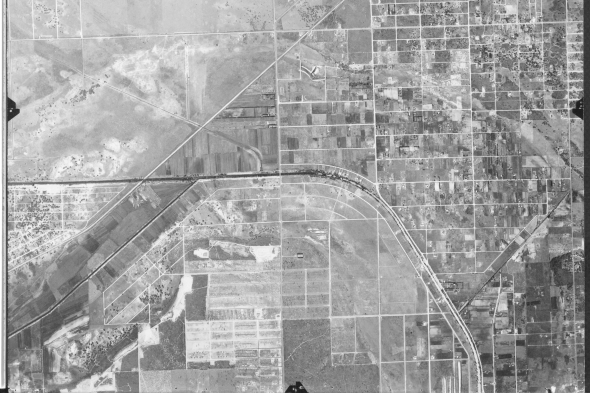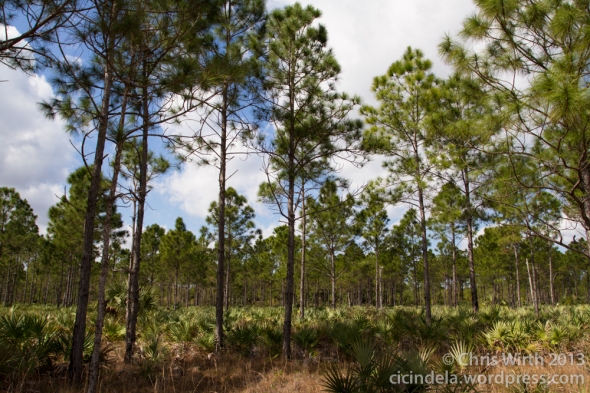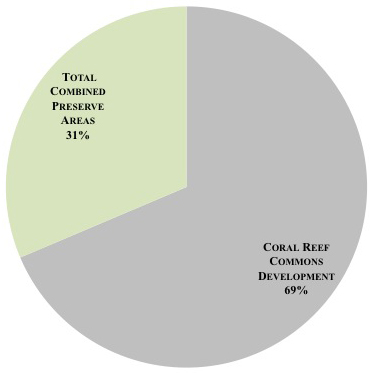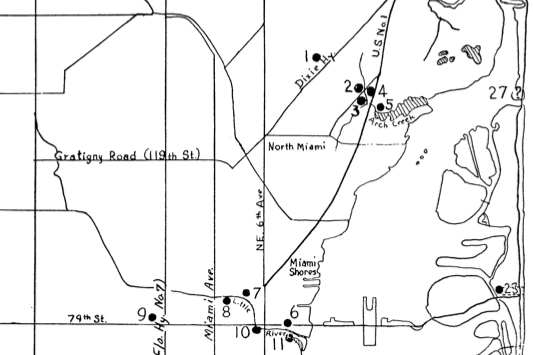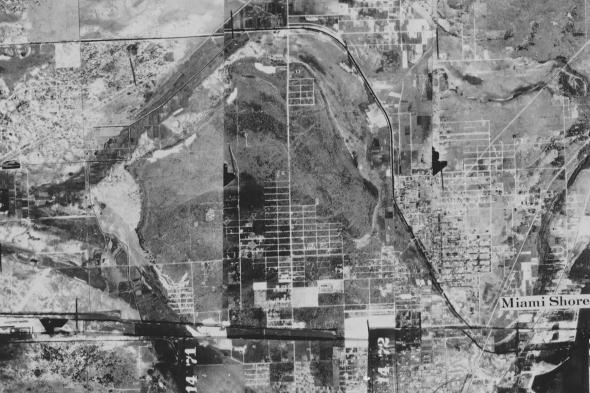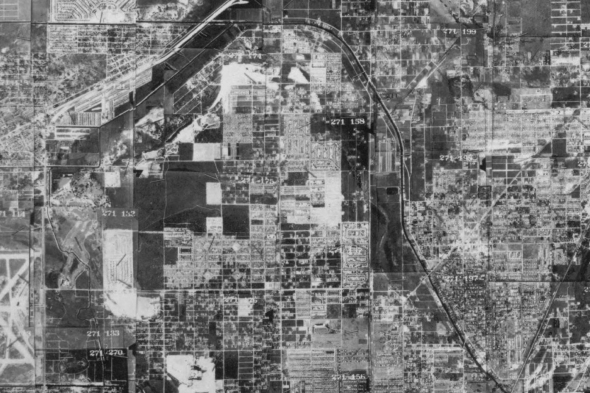The Miami tiger beetle receives “Endangered” status

The Miami tiger beetle, Cicindelidia floridana, and its story are unique. An 18-year-old student first collected the species in 1934 from pine rockland habitat in northern Miami-Dade. Pine rocklands were once the dominant habitat in south Florida, extending from the Florida Keys to the northern border of Miami-Dade County, but development has steadily engulfed this habitat. Today 1.8% of the metro Miami-Dade pine rocklands remain standing.
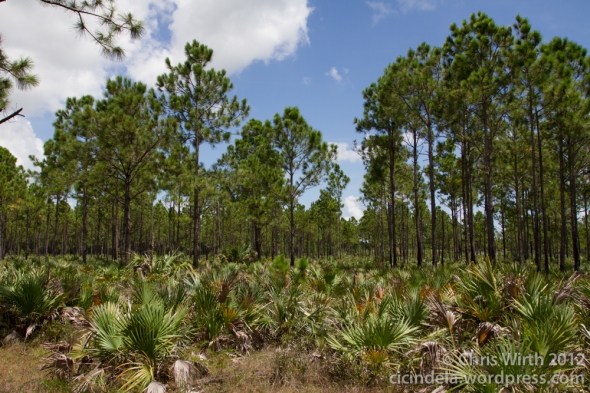
In the context of this widespread habitat loss and seventy years without any beetles observed the Miami tiger beetle was presumed extinct. But, in 2007 a population of Miami tiger beetles was rediscovered in the Richmond Heights pine rocklands, the largest contiguous remaining rocklands in Miami-Dade (below), and in 2015 a second population was found at an undisclosed patch of pine rocklands nearby.
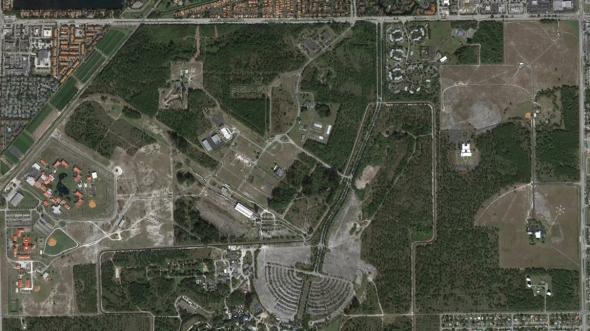
The Miami tiger beetle faces the immediate threats of habitat loss, degradation, and fragmentation from inadequate habitat management and two proposed developments; a mixed-use development, Coral Reef Commons (below) and a major theme park, Miami Wilds.
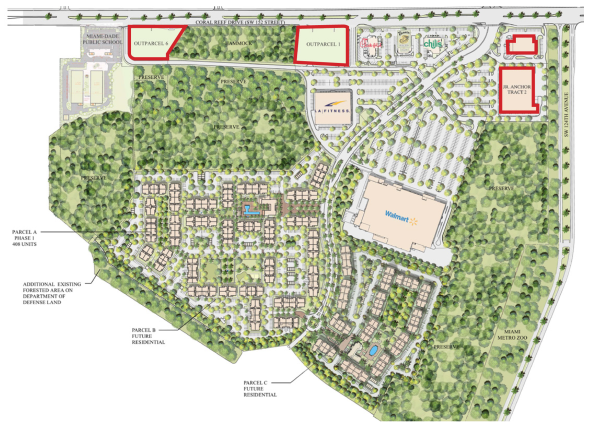
Distressingly, the species is also actively sought by private, non-scientist tiger beetle collectors due to its extreme rarity.
On December 11th 2014, the Center for Biological Diversity, Miami Blue Chapter of the North American Butterfly Association, South Florida Wildlands Association, Tropical Audubon Society, Sandy Koi, Al Sunshine, and I submitted a petition to U.S. Fish and Wildlife Service, urging the Miami tiger beetle be formally listed under the Endangered Species Act.
Today, on October 4th 2016, the Service announced the Miami Tiger Beetle will receive “endangered” status under the Endangered Species Act which will become effective on November 4th 2016.
The Miami tiger beetle joins other Federally listed (threatened and endangered) pine rockland endemics, including the Florida Bonneted bat (Eumops floridanus), Florida leafwing (Anaea troglodyta floridalis), Bartram’s hairstreak (Strymon acis bartrami), Blodgett’s silverbush (Argythamnia blodgettii), Florida brickell-bush (Brickellia mosieri), Big Pine partridge pea (Chamaecrista lineata var. keyensis), deltoid spurge (Chamaesyce deltoidea deltoidea), wedge spurge (Chamaesyce deltoidea serpyllum), Carter’s small-flowered flax (Linum carteri carteri), sand flax (Linum arenicola), and tiny polygala (Polygala smallii).
This species also joins other listed members of the Cicindelinae; there are two endangered tiger beetle species (Cicindela ohlone and Ellipsoptera nevadica lincolniana) and two threatened species (Ellipsoptera puritana and Habroscelimorpha dorsalis dorsalis).
However, no critical habitat has been proposed or designated at this time:
While the designation of critical habitat is prudent, the Service is delaying a proposed designation at this time and expects to complete work on it by September 30, 2017. In addition, there is a proposal to build two developments in the Richmond Pine Rocklands and the Service continues to work with developers.
It would appear that the interests of a few private individuals at Ram Realty and Miami Wilds LLC are taking precedence to the survival of the Miami tiger beetle, its fellow pine rockland endemic species, and the last 1.8% of the metro Miami-Dade pine rocklands. The publicly available plans released by the Coral Reef Commons and Miami Wilds developers show that un-surveyed pine rocklands and Miami-tiger-beetle occupied habitat, respectively, will be paved over and the stifling development will severely limit any management of the remaining habitat, chiefly by preventing controlled burns which pine rocklands and their inhabitants depend upon.
Despite this shortcomings, I sincerely thank the staff members of the South Florida Ecological Service. I’d also like recognize the efforts of my fellow Petitioners and extend my thanks.
Please stay tuned to this blog for updates on the Miami tiger beetle and its habitat.

References
Bousquet, Y. 2012. Catalogue of Geadephaga (Coleoptera, Adephaga) of America, north of Mexico. ZooKeys 245:1-1722.
Brzoska, D., C.B. Knisley, and J. Slotten. 2011. Rediscovery of Cicindela scabrosa floridana Cartwright (Coleoptera: Cicindelidae) and its elevation to species level. Insecta Mundi 0162:1-7.
Cartwright, O.L. 1939. Eleven new American Coleoptera (Scarabidae, Cicindelidae). Annals of the Entomological Society of America 32:353-364.
Center for Biological Diversity. 2016. Four Florida Plants Protected Under Endangered Species Act. Press Release. September 28, 2016
Florida Natural Areas Inventory (FNAI). 2010. Pine Rockland, in Guide to the natural communities of Florida: 2010 edition. Florida Natural Areas Inventory, Tallahassee, FL. 8 pp.
Knisley, C.B. 2008. Current status of the “Miami” tiger beetle. Final Report. October 28, 2008.
Knisley, C.B. 2011. Taxonomy, biology, and conservation of the Florida tiger beetle. Final Report to South Florida Ecological Services Office. February 20, 2011.
Knisley, C.B. 2013. Biological studies of the Florida tiger beetle, 2011-2013. Final Report. April 13, 2013.
Knisley, C.B. 2015. Species assessment of the Miami tiger beetle, Cicindelidia floridana. Revised Report. June 6, 2015.
Knisley, C., M. Kippenhan, and D. Brzoska. 2014. Conservation status of United States tiger beetles. Terrestrial Arthropod Reviews. 7: 93-145.
Natureserve 2016. NatureServe Explorer: An online encyclopedia of life. Version 7.0.
Pearson, D.L., C.B. Knisley, and C.J. Kazilek. 2006. A field guide to the tiger beetles of the United States and Canada: Identification, natural history and distribution of the Cicindelinae. Oxford University Press, New York.
Pearson, D.L., C.B. Knisley, D.P. Duran, and C.J. Kazilek. 2015. A field guide to the tiger beetles of the United States and Canada: Identification, natural history and distribution of the Cicindelinae. Second edition. Oxford University Press, New York.
U.S. Fish and Wildlife Service. South Florida Multi-Species Recovery Plan: Appendix C. Species of Concern and their Associated Community Types in South Florida.
URS Corporation, The Institute for Regional Conservation, and Muller and Associates, Inc. 2007. Miami Dade County Environmentally Endangered Lands Program Management Plan, Part II: Management of specific habitat types, Chapter 1: The pine rockland habitat. Submitted to Environmentally Endangered Lands Program, Miami, Florida by URS Corporation. K.A. Bradley, G.D. Gann, M.J. Barry, contributors.
USFWS Miami Tiger Beetle Hearing: Comments
Introduction:
On December 11th 2014, the Center for Biological Diversity, Miami Blue Chapter of the North American Butterfly Association, South Florida Wildlands Association, Tropical Audubon Society, Sandy Koi, Al Sunshine, and I (the Petitioners) submitted a petition to U.S. Fish and Wildlife Service (the Service), urging the Miami tiger beetle (MTB), Cicindelidia floridana, be formally listed under the Endangered Species Act.
A full year and seven days later, on December 18th 2015, the Service proposed “endangered” status for the MTB, and announced a “hearing for members of the general public to comment on that proposal in person,” as required by Section 4(b)(5) of the Endangered Species Act.
This public hearing was held on January 13, 2016 at Miami-Dade College’s Kendall campus and I flew in from Arizona to attend. I’ve already posted a brief synopsis, audio, and photos from the hearing and in this post I’m going to respond to “three” commenters.
USFWS Miami Tiger Beetle Public Hearing
With the December 2015 announcement by the U.S. Fish and Wildlife Service (Service) of proposed “endangered” status for the Miami tiger beetle (Cicindelidia floridana), a “hearing for members of the general public to comment on that proposal in person” was scheduled, as required by Section 4(b)(5) of the Endangered Species Act. This public hearing was held on January 13, 2016 at Miami-Dade College’s Kendall campus and I flew in from Arizona to attend. To listen to audio from the hearing click here or keep reading for my photos and some brief comments.
Shortly after 5pm I made my way across Miami-Dade College’s Kendall campus to their main auditorium. As I approached the auditorium entrance I saw half a dozen law enforcement officers monitoring the proceeding; two officers at a sign-in table next to the entrance, two at table on the opposite side, and, in between, two at the auditorium doors. Even inside the auditorium there was a USFWS Refuge officer at each entrance, further reinforcing the seriousness of this federal hearing.
Even through I was early there were over twenty people already present, both members of the public and Miami-Dade college students. As I waited for the start of the hearing I chatted with the USFWS officials present and picked up copies of their Miami tiger beetle factsheet and FAQ.
Prominently displayed were two posters depicting the historical and current (only 1.8% remains) pine rocklands in Miami-Dade county and the Richmond Heights pine rocklands, the primary habitat for the Miami tiger beetle. At a glance it is clear the drastic, almost complete, loss of pine rocklands within Miami-Dade county:
The hearing began with an informative presentation on the beetle and then the public comment period began. Among those speaking were myself, the lobbyist/head of Miami Wilds LLC, Paul Lambert, concerned citizens, and members of the Miami Pine Rocklands Coalition. I’ve included selected audio from the hearing below:
I will respond to Mr. Lambert/Miami Wild’s concerns and the ecologist’s comments in a second post. Additionally I’ll post my full comments to the Service in a separate post.
Please don’t forget the public comment period on USFWS’s proposal to list the Miami tiger beetle as endangered is still open (until February 22, 2016). To submit a comment to the Service go to the official site and click comment now.

(L-R) Sonya Thompson (Miami-Dade County), Chris Wirth (Cicindela blogger & Miami tiger beetle petitioner), Sandy Koi (Miami tiger beetle petitioner), Belén Valladares (Miami Pine Rocklands Coalition vice-president), Al Sunshine (Miami Pine Rocklands Coalition president & Miami tiger beetle petitioner).
Acknowledgements
I’d like to extend special thanks to Miami Pine Rocklands Coalition Vice-President Belén Valladares for providing transportation and lodging during my trip.
A Second Miami Tiger Beetle Population Discovered
Note: This post was largely written in August, however I held off publishing due to the sensitive nature of this discovery. This Friday the U.S. Fish and Wildlife Service proposed listing the Miami tiger beetle as an endangered species and announced the existence of a second population of the MTB. With this official confirmation I’m publishing this post in hopes of contributing some context and further information about this population.
The story of the Miami tiger beetle, Cicindela floridana, a beautifully iridescent tiger beetle presumed extinct but rediscovered in 2007 is unique. This fiercely predatory beetle is a south Florida endemic only known from pine rocklands, a habitat once common in Miami-Dade county but, due to extensive development, today only 1.8% of the metro Miami-Dade rocklands remain.
The entomologist Frank N. Young Jr., an 18 year old student at the time, discovered the Miami tiger beetle from pine rocklands in 1934 at a site in northern Miami-Dade county. However, by 1947 this habitat was lost to development as the native pine rocklands were transformed into the neighborhoods of north Miami and Miami Shores (below).
In 2007, after a 73 year absence and presumed extinction, the Miami tiger beetle was rediscovered near Zoo Miami in pine rocklands. This site is part of the Richmond Heights pine rocklands, the largest contiguous remaining areas of this habitat in metro Miami-Dade. Spurred by this rediscovery entomologists surveyed pine rocklands throughout southern Florida in search of the Miami tiger beetle.
Extensive surveys were conducted in both scrub habitats and most of the pine rockland sites in Miami-Dade, Ft. Lauderdale and Palm Beach Counties (Knisley, 2008). Most were unsuitable probably because they were too densely vegetated or the substrates were mostly oolitic limestone rock with few or no sand patches (Knisley et al. 2014).
Despite these efforts in the years since its remarkable rediscovery the Miami tiger beetle had only been found at a handful of directly adjacent sites in the Richmond Heights pine rocklands. Even the known population is few in number (under a hundred adult beetles observed) and face further threats of vegetation encroachment and potential habitat development (see here for more).
This changed in July when Jimmy Lange, a field botanist at Fairchild Tropical Botanic Garden, and Alyssa Dawson, an intern from Ohio University, were surveying an undisclosed patch of pine rocklands for rare plants (namely Brickellia mosieri, an endangered species) when, as Lange describes it, “[i]n my meanderings I was [documenting] other rare species as I encountered them … when I bumped into a tiger beetle.” But this was not just any tiger beetle, Lange and Dawson found three Miami tiger beetles (Cicindela floridana).
Lange and Dawson’s discovery offers a small boost to the hopes for the survival of the Miami tiger beetle. But even with the discovery of the second population the MTB is still in danger. The MTB habitat, pine rockland, has been extensively developed and today only 1.8% of the metro Miami-Dade pine rocklands remain. These habitats are also under the constant threat of vegetation encroachment primarily due to the lack of controlled burns (which pine rocklands depend upon).
A major question regarding this second population of MTBs is whether the discovery of new populations would alter the expert’s rating of the species as seriously imperiled and recommendation for formal protections (Knisley et al. 2014). In brief this second population does not significantly alter the Miami tiger beetle’s current standing. First, this “population” is represented by three observed beetles and thus likely does not provide a sufficient number of individuals to contribute to the species survival. Second, Knisley et al. (2014) account for the existence of other populations in their recommendation methods:
Examples of our grading system are as follows: A 1 would be comparable to the NatureServe grade of 1, usually with five or fewer known populations and significant threats; a 1+ would be at the upper range of these factors and 1- at the lower range.
For the 1 +/- grade given by Knisley a species must face significant threats which is absolutely the case for the MTB. Most significantly both populations face the “loss, degradation, and fragmentation” (USFWS) of habitat, primarily from the constant encroachment of vegetation, both ecological succession due the lack of fires and invasive species.
Of particular note the U.S. Fish and Wildlife Service did not release the location of this new population due to the threat of collection:
Tiger beetles are in high demand and avidly collected. We are aware of internet advertisements for the sale and trade of other florida tiger beetles.

Ram Realty’s “Technical and Legal Submittal” and “Supplemental Response” to the Miami Tiger Beetle Emergency Listing Petition
In response to a December 11, 2014 emergency listing petition to protect the Miami tiger beetle (Cicindela floridana) filed by the Center for Biological Diversity, advocacy groups, and several individuals (myself included), Ram Realty retained the law firm Gunster, “Florida’s Law Firm for Business,” to craft their reply to the U.S. Fish and Wildlife Service (USFWS).
Luna E. Phillips is a “Florida Bar board certified Gunster shareholder who practices in the area of environmental, administrative and governmental law [and] leads the firm’s Environmental practice” (from Gunster’s website) wrote and submitted two responses to USFWS totaling some 7,500 words! However, in both of these documents there are serious systematic errors and fatal misunderstandings or, even worse, flagrant misrepresentation of the science. Below I’ve reproduced both of Ram’s filings in red and my comments in black.
Technical and Legal Submittal regarding the December 11, 2014 Emergency Listing Petition Filed by the Center for Biological Diversity, et al:
January 14, 2015
Dear Ms. Blackford:
As you know, this firm represents Coral Reef Retail LLC and Coral Reef Resi Ph I LLC, the owners of the Coral Reef Commons property (Coral Reef Owners). Enclosed is a Technical and Legal Submittal regarding the December 11, 2014 Emergency Listing Petition filed by the Center for Biological Diversity, et al. This Technical and Legal Submittal identifies the flaws in the emergency petition, and the Coral Reef Owners urge the US. Fish and Wildlife Service to carefully review before making a determination on the emergency petition.
The Coral Reef Owners respectfully request that this Technical and Legal Submittal be added to the administrative record for the Miami tiger beetle potential listing, and should the Service make any determinations on the emergency petition, Coral Reef Owners request to be notified. Please do not hesitate to contact me at – or via email – if you have any questions regarding the content of this letter.
Sincerely,
[Signed]
Luna E. Phillips
cc: Vicki Mott, US. Department of the Interior
Client [Ram Realty]
Rafe Petersen, Holland & Knight
Church Roberts, Johnson Engineering, Inc.
Paving pine rocklands = saving them?
In a March 7th letter to the editor Ram Realty chairman Peter D. Cummings defiantly responded to the public outcry over Ram’s plans to develop a significant tract of pine rocklands. He claimed that the development of this site in the form of Coral Reef Commons, a mixed-used residential and commercial complex, is the only viable option to preserve the pine rocklands. However, I’ve spent significant time conducting research in the surrounding Richmond Heights pine rocklands and Mr. Cummings’s claims continue to misrepresent the actual state of the Coral Reef Commons (CRC) site and its development. From his letter:
The development of Coral Reef Commons is the last, best hope for preservation of a major portion of the habitat.
This is simply not true. Mr. Cummings can paint a rosy picture of gentle development but Ram’s plans are to develop over two-thirds of the property. This simply does not preserve a significant portion of the critically endangered habitat.
As it currently sits, the area is severely degraded. Calling it pristine pine rockland isn’t accurate; every objective person that has walked the site agrees. It hasn’t been pristine for more than 70 years, since the U.S. government razed the area to build a blimp base during World War II. It is overrun by exotic non-native species that are choking out the native flora…
Yes, the site is degraded, but it is still able to be restored if Ram does not pave over the site. The foundation of pine rocklands is the oolitic limestone substrate and this is virtually intact on the property. The CRC site was not razed by the Navy to build the NAS blimp base; the property was home to various barracks and administrative buildings during and after the war. The next owner, the University of Miami, grossly mismanaged this area. The present poor condition of the site is due to the lack of any facility or habitat management by the University, not excessive development. The school even denied access requests from myself and other researchers to this and their other properties around Zoo Miami.
Rather than engage in knee-jerk reactions to unfounded claims, conservationists and the Herald should look to the commitment Ram has made to restore and preserve close to 50 percent of the site.
I’ll just let Ram’s actual numbers speak here:
The whole Coral Reef Commons site is 137 acres but Ram’s planned preserves total just 43 acres (not all of it pine rockland) – just over 30% of the property. So, contrary to Ram’s claims, under a third of this property will be preserved.
The new mixed-use community will be developed on a portion of the property that is most degraded — the site of an abandoned incinerator, shells of gutted buildings that once housed labs, abandoned trash piles, roads and monkey cages.
How do they propose to do this? Here is the actual status of the property:
Presently 47% of the CRC site is pine rocklands and a further 19% is other, largely hardwood, forest. About 22% of the site is green space, minimally modified from their original state, and a final 12% is heavily modified or developed (buildings, major roads, and parking lots). This is not the heavily developed, hopeless situation the Ram paints.
… Environmentalists want someone to buy the land to restore it, and that is exactly what we are doing.
On the left is an aerial photograph from 1938 before any development of the CRC site (outlined in red); notice intact pine rockland habitat. In the center is an image from 1952, after the peak of Richmond Naval Air Station. And on the right is a 2014 satellite image (from Google Earth). Notice how little of the overall CRC site has actually been significantly altered.
These pine rocklands have survived comparatively unscathed since the early logging and military developments on the site in the 1940s and these Richmond Heights rocklands represent a quarter of the 1.8% of this habitat left outside the Everglades National Park. Any further development seriously jeopardizes the rocklands and their inhabitants, principally by further fragmenting the remaining rocklands and stifling brush fires, a necessary ecological cycle for survival of the habitat.
The solution is not to develop over two-thirds of the site and its pine rocklands. Under one-eighth of the Coral Reef Commons site has been developed. Perhaps there is a more appropriate use for this rare habitat than yet more development. Let’s restore and preserve the seven-eighths of the property that is undeveloped and constructively use or mitigate the fraction of the property that is already developed. Pine rocklands are a unique and valuable part of Florida’s natural history and are worth preserving.
Notes
Areas for which exact figures were not available were estimated with the polygon tool in Google Earth and the polygon area calculator on earthpoint.us.
References
URS Corporation, The Institute for Regional Conservation, and Muller and Associates, Inc. 2007. Miami Dade County Environmentally Endangered Lands Program Management Plan, Part II: Management of specific habitat types, Chapter 1: The pine rockland habitat. Submitted to Environmentally Endangered Lands Program, Miami, Florida by URS Corporation. K.A. Bradley, G.D. Gann, M.J. Barry, contributors.
Blight?
[The Committee] accepts the Study identifying approximately 2,146 acres within the unincorporated municipal service area (UMSA), which lie entirely in Commission District 9 represented by Commissioner Dennis C. Moss, to be slum and blighted.
Miami-Dade Legislative Item 142509
This month a Miami-Dade county committee approved a resolution from county commissioner Dennis Moss to designate the Richmond Heights pine rocklands (the largest fragement of pine rocklands outside the Everglades National Park and the only habitat of the Miami tiger beetle) along with the surrounding lands “a slum or blighted area.” This resolution stemmed from a county-commitioned study supplied by the firm Calvin, Giordano & Associates which built a tenuous case that slum or blight conditions exist in and around the Richmond Heights pine rocklands. The Committee forwarded the resolution to the full Board of County Commissioners for consideration:
It is recommended that the Board of County Commissioners … consider taking the following actions:
4. The Board declares and finds that there is a need for a community redevelopment agency to function and carry out the community redevelopment purposes of the Act; and
5. The Board directs the County Mayor or the County Mayor’s designee to prepare a plan of redevelopment for the Area, and to submit the plan of redevelopment to the Board for approval after notice and public hearing.
Should a community redevelopment agency be created, the Area covered will make it the second largest in the County, with only the North Miami Community Redevelopment Agency larger at 3,540 acres. The Study includes the Zoo Miami, Coast Guard, and the former University of Miami properties.
Miami-Dade Legislative Item 142509
The goal in establishing the existence of slum or blight conditions and subsequent community redevelopment agency (CRA) is to create a special tax district¹ which will channel public funds into development of the site. The development in question is the $930 million theme park, Miami Wilds. As I have written previously the construction of this theme park (in its present incarnation) is a serious and unacceptable threat to the Richmond Heights pine rocklands and the survival of numerous endangered species, including the Miami tiger beetle, a candidate for emergency state and federal protection.
The developers, Miami Wilds LLC, have already received approval for an initial $13.5 million in bond funds to replicate the US Coast Guard communications tower array which currently stands in the footprint of the theme park. However, use of this land requires Federal permission and approval of the developer’s plans; approval which has not yet been given.
The Richmond Heights pine rocklands have survived comparatively unscathed since the since the early development of the site in the 1940s and these lands represent a major portion of the 1.8% of pine rocklands left outside the Everglades National Park. Any further development seriously jeopardizes the rocklands, chiefly by fragmenting the remaining habitat and stifling fires, a necessary ecological cycle for the continued health of the habitats.
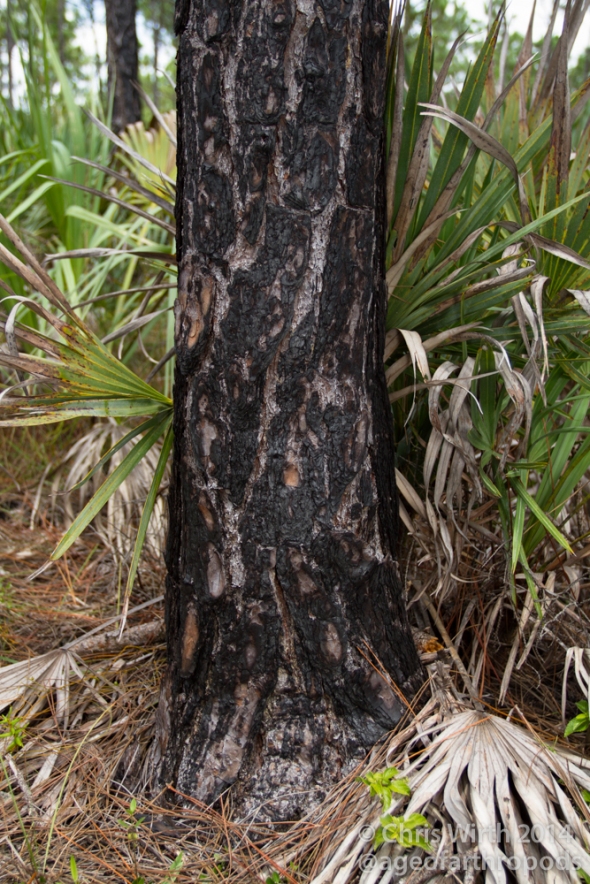
Proper management of pine rockland fragments includes prescribed burning (which can generate heavy amounts of smoke)… Construction of hospitals, schools, apartments, and hotels around [rocklands] should be discouraged because of conflicts with smoke generation during prescribed fires. URS Corporation et al 2007
These current plans for Miami Wilds and Coral Reef Commons will severely fragment the remaining Richmond Heights pine rocklands. Once these rocklands are surrounded by heavy development any prescribed burning will be extraordinarily unlikely.
… maximize open space and limit pollution runoff [around rocklands]. URS Corporation et al 2007
A secondary impact of any development is that without sufficient buffer areas around the rocklands the new fragments will be highly susceptible to pollution and encroachment of non-native and invasive animals and plants from the surrounding.
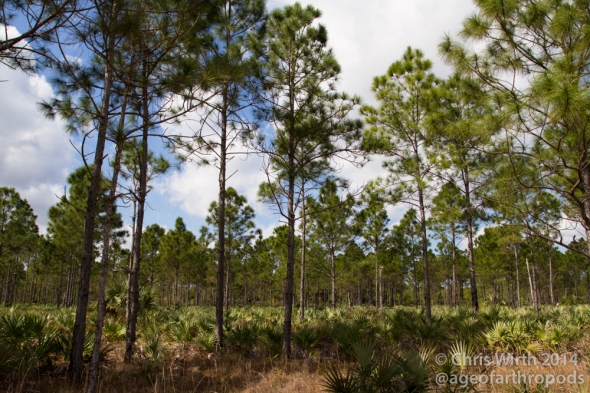
The current plans for development do not adequately conserve these imperiled rocklands and are not a reasonable option for the continued survival of this unique habitat and its inhabitants. Over 98% of the Miami-Dade rocklands have been lost to development. There are better options for utilization of the non-rockland areas, options which do not fragment or destroy rocklands, alternatives which provide adequate buffers to facilitate the necessary management of the habitat.
The “blight” resolution has been forwarded to the Board of County Commissioners for consideration and a full public hearing on January 21st.
Local residents are planning a rally for the rocklands on January 17th
The Center for Biological Diversity has a letter to the Miami Board of County Commissioners which you can sign and send in support of preserving the pine rocklands.
View the resolution here. Read the Calvin, Giordano & Associates study here.
Also see the Miami Herald article on the this latest development.
Notes
¹In designating an area as a CRA governing bodies are afforded the opportunity to leverage public financing for the purpose of land acquisition, demolition, housing and infrastructure improvements, environmental remediation, neighborhood enhancement and other similar activities. This is accomplished through a funding mechanism known as Tax Increment Financing (TIF). From MetroZoo Finding of Necessity Study 2014 Update
References
URS Corporation, The Institute for Regional Conservation, and Muller and Associates, Inc. 2007. Miami Dade County Environmentally Endangered Lands Program Management Plan, Part II: Management of specific habitat types, Chapter 1: The pine rockland habitat. Submitted to Environmentally Endangered Lands Program, Miami, Florida by URS Corporation. K.A. Bradley, G.D. Gann, M.J. Barry, contributors.
Emergency protection sought for Miami tiger beetle
Today the Center for Biological Diversity filed emergency petitions to protect the exceedingly rare Miami tiger beetle, Cicindela floridana, a South Florida pine rocklands endemic, as a protected species under Florida law and as endangered under the federal Endangered Species Act.

Pine rocklands once stretched from the Florida Keys up to the northern edge of Miami-Dade County, but widespread urbanization and agricultural development destroyed the majority of Floridian pine rockland. This fire-dependent community, found on limestone outcroppings, is comprised of a sparse canopy dominated by Florida slash pine, Pinus elliotti var. densa, and a varied understory. Today, only a fraction of the original Miami pine rockland habitat remains; by some estimates as little as 1.8%. Moreover, most of these remaining areas are quite small and often widely separated by miles of heavy development.
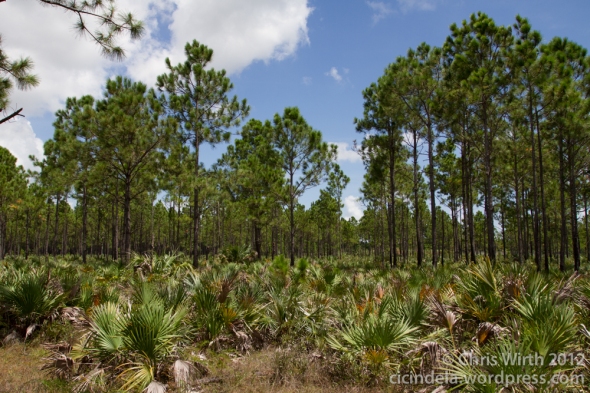
The pine rockland habitats are home to many endemic species, many of which are listed as endangered including the Florida Bonneted bat (Eumops floridanus), Bartram’s hairstreak (Strymon acis bartrami), Florida leafwing (Anaea troglodyta floridalis), Florida brickell-bush (Brickellia mosieri), deltoid spurge (Chamaesyce deltoidea deltoidea), Carter’s small-flowered flax (Linum carteri carteri), tiny polygala (Polygala smallii).
Today many of these remaining pine rocklands and their inhabitants now face another danger; due to the lack of fire, both native and non-native vegetation are taking over the habitats which incrementally transitioning to hardwood hammocks.
Of greatest concern is the Richmond Heights pine rocklands, where the Miami tiger beetle was rediscovered in 2007. In addition to vegetation encroachment, there are plans to develop significant portions of the pinelands. The first, and most immediate, is Ram Realty’s plan to develop and 88-acre parcel of rocklands purchased from the University of Miami.
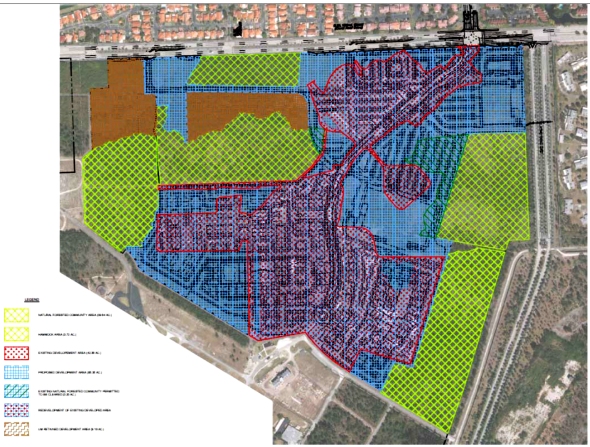
While Ram has set aside some of the land for nature preserves, any development seriously jeopardizes the rocklands by fragmenting the remaining habitat and stifling fires, a necessity for the continued health of the habitats. The second, and most expansive in scope, is the county’s plan to develop a major amusement park in and around the rocklands.
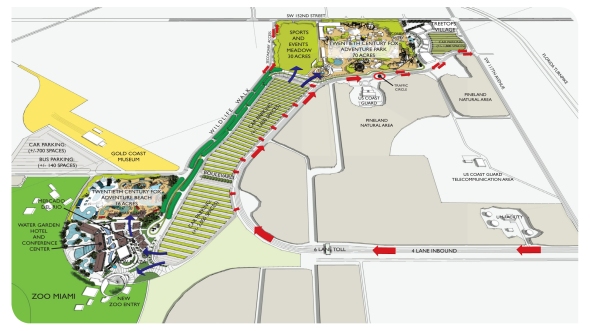
This plan calls for major development including a four lane highway and major transportation corridor through the rocklands. This development will irrevocably damage all of the Richmond pine rocklands, through fragmentation, pollution, and stifling fires within the remaining habitat.
Both development pose real and immediate risks to endangered and rare species, including the Miami tiger beetle. These developments will results in the destruction and degradation of pine rocklands and will kill endangered and candidate species including the adults and larvae of the Miami tiger beetle.
Even before the current plans for development the Miami tiger beetle (Cicindela floridana) was a U.S. Fish and Wildlife Service species of concern. Additionally, Knisley et al (2014) assigned the Miami tiger beetle a 1+ grade, their “highest level of rarity and/or threats” in a comprehensive review of the conservation status of United States tiger beetles. With over 98% of the potential former habitat gone and direct threats to the only remaining habitat this species is in need of urgent action to prevent its extinction.
The Center for Biological Diversity’s press release is available at their website.
References
Knisley, C., M. Kippenhan, and D. Brzoska. 2014. Conservation status of United States tiger beetles. Terrestrial Arthropod Reviews. 7: 93-145.
U.S. Fish and Wildlife Service. South Florida Multi-Species Recovery Plan: Appendix C. Species of Concern and their Associated Community Types in South Florida.
URS Corporation, The Institute for Regional Conservation, and Muller and Associates, Inc. 2007. Miami Dade County Environmentally Endangered Lands Program Management Plan, Part II: Management of specific habitat types, Chapter 1: The pine rockland habitat. Submitted to Environmentally Endangered Lands Program, Miami, Florida by URS Corporation. K.A. Bradley, G.D. Gann, M.J. Barry, contributors.
The type locality of Cicindela floridana
Readers of this blog may be familiar with the story of Cicindela floridana, a beautifully iridescent tiger beetle presumed extinct but rediscovered in 2007. This beetle is only known from pine rocklands, a habitat once common in southern Florida but only 1.8% of the original rocklands remain today (outside of the Everglades National Park).

Frank N. Young Jr. collected this species while he was an 18 year old student and gives only vague locality information on his labels. In the rediscovery paper Brzoska, Knisley, and Slotten note that:
The exact type locality for var. floridana is problematic. Cartwright (1939) gives the locality as Miami, Florida based on Young’s label. In the 1980s, R. L. Huber, in an attempt to locate this form contacted Young who told him the specimens were collected in the vicinity of Gratigny Road while he was studying land snails in the sandy hammocks. …. Knisley also contacted Young in the early 1990s and learned that the specimens were taken in the vicinity of Barry [University].
My curiosity piqued, I combed through Frank Young’s publications and found a 1951 paper “Vanishing and extinct colonies of tree snails, Liguus fasciatus, in the vicinity of Miami, Florida.” In this paper Young includes a map of his study sites, which are tantalizingly close to Gratigny Road and Barry University (located south of Gratigny St. and Miami Ave). If there is a connection between Young’s early snail hunting and this 1951 paper and we might be able to pinpoint the type locality of C. floridana.
Further on Young writes:
The distribution of the hammocks around Arch Creek shows the same general pattern as those around New River to the north or Little River to the south. That is, the hammocks occur along the margins of the stream or its estuary, across the rocklands of the East Coast ridge, and fan out along the edges of the transverse glade. This pattern is apparently maintained by the nature of the soils and the periodic fires which sweep the bordering rocky pinelands and encroach upon the edges of the hammocks.
This paper suggests that the area around Gratigny Road and Barry University may have been pine rocklands and substantially narrows the potential area in which Young may have collected the type series in 1934. In this 1947 topographic map you can see that the area around (and north of) Gratigny Road and Barry University is slightly elevated from the surrounding, consistent with (but not necessarily indicative of) pine rocklands habitat.
Almost convinced, I searched the aerial photography of Florida collections at the University of Florida Digital Collections and found several index images which included my area of interest. I was unable to find any imagery taken earlier than 1940; however, even the 1940 photograph confirmed my hunch. In this image the land north and west of (what would become) Barry University and Gratigny Road there appears to a partially isolated stand of pines.
This location matches Young’s comments to Huber and Knisley; Gratigny Road runs through these pines which extend into what would become Barry University. But, even in the six years after Young collected the type series of C. floridana there appear to have been significant new development visible (including Barry University, founded in 1940) and the areas east and southeast of the canal are already heavily built up.
This fall I received a note from Knisley, forwarded from Huber, with an exciting message. Huber had found a detailed entry from his collecting notes; this gave an exact location for Young’s specimens:
30 May 1972, visited the intersection of Miami Ave and Gratigny Rd (=119th St). Frank Young said that he had taken floridana in the NE corner of that intersection.
Bingo! Here is the type locality of C. floridana in detail:

The next image (showing the area just north of Gratigny St.) is from 1947 and the pines appear to have been largely cut down and the area has been divided up into parcels. I find it unlikely that C. floridana would have occurred at the type locality in 1947, though perhaps to the west where there appear to still be some pines standing.
The development dramatically increases in 1949-50 and the whole area is largely housing by 1950. Any rocklands habitat that remained after this time was certainly too fragmented and poor quality to sustain a population of C. floridana.
- 1940
- 1947
- 1950
- 1956
- 1970
- 2014 (from Google Earth)
References:
Brzoska, D., C.B. Knisley, and J. Slotten. 2011. Rediscovery of Cicindela scabrosa floridana Cartwright and its elevation to species level. Insect Mundi 2011 162:1-7.
URS Corporation, The Institute for Regional Conservation, and Muller and Associates, Inc. 2007. Miami Dade County Environmentally Endangered Lands Program Management Plan, Part II: Management of specific habitat types, Chapter 1: The pine rockland habitat. Submitted to Environmentally Endangered Lands Program, Miami, Florida by URS Corporation. K.A. Bradley, G.D. Gann, M.J. Barry, contributors.
Young, F. N. 1951. Vanishing and extinct colonies of tree snails, Liguus fasciatus, in the vicinity of Miami, Florida. Occasional Papers of the Museum of Zoology, University of Michigan. 531: 21 p.
















